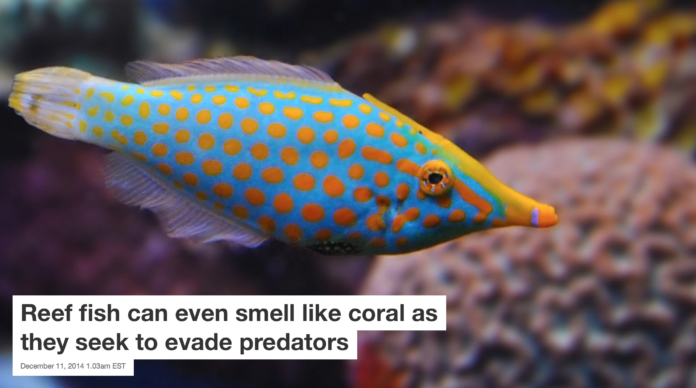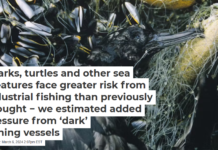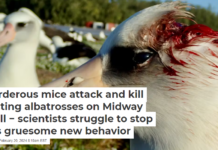
By Rohan Brooker, Georgia Institute of Technology
The animal kingdom is full of incredible examples of camouflage, with animals resembling objects found in their environment such as sticks or leaves, or displaying colour patterns that permit them to blend into their surroundings to hide from predators or prey.
Many animals interact with the world using other senses, such as smell. Yet most of our understanding of animal camouflage is based on visual mechanisms, probably due to our own reliance on sight. Can animals camouflage their own smell to avoid detection? As predators often use smells to locate prey, even the visually camouflaged can stick out if they still smell strongly like lunch.
In a paper published by the Royal Society, our study reveals that a small colourful fish, the harlequin filefish, can change its odour to hide from hungry predators. Evolution has a tendency to produce countermeasures in this way; an animal could employ some mechanism to mask or diminish its odour, either by limiting the smell it produces, or altering it to match smells present within its habitat.
One way this could happen is via the diet: odour producing chemicals from the food transferred to the animal that causes their smells to match – similar to what happens if you eat a lot of garlic. This has been shown in some caterpillars that live on the plants they also use for food. Chemicals in the plants, when digested, are transferred to the caterpillars, making them indistinguishable from the plant itself, causing predatory ants to walk right over them, oblivious. Evidence for similar processes in other animals has remained scarce, meaning it’s unknown how commonplace “chemical camouflage” is.
Underwater disguises
The harlequin or orange-spotted filefish is found on coral reefs throughout the Indian and Pacific oceans, including at Lizard Island in the northern Great Barrier Reef where we conducted this work.
It is very selective about what it eats, choosing to nibble on only certain corals. It also uses these corals as habitat at night, hiding in among the coral branches making it very hard to spot. To determine if these filefish smell like the coral they eat, we recruited coral-dwelling crabs to test if these crabs could tell the difference between the smell of filefish and corals. These tiny crabs live tucked away in among the coral, with each type of coral having its own species of crab.
In the study, the crabs could distinguish between filefish that were fed different corals, preferring those fish who fed on the coral the crabs lived in. In fact, the filefish smelled so strongly of coral that sometimes the crabs were attracted to the fish instead of coral itself.
Smelling like coral is all well and good, but it’s not much use if you still end up being eaten. To test if smelling like coral reduced the ability of predators to detect filefish in the surrounding habitat, we ran a second experiment, this time using large predatory blue-spotted rock cod.

Smell like coral, get ignored by predators – seems a good exchange.
Tane Sinclair-Taylor, Author provided
Cod, filefish and corals were put in a tank, with the filefish hidden from the cod. When the filefish diet matched the corals in the tank, the cod stayed tucked away in their cave inside the tank. However, when the filefish diet didn’t match the corals in the tank, the cod were restless, suggesting they smelled food. This implication is that matching the smell of your habitat could be a good way to avoid drawing unwanted attention.
This is the first evidence of an animal other than an insect camouflaging its odour using chemicals derived from its diet. The next step will be to determine exactly how filefish can smell like coral and much work remains to understand this set of biological processes.
We know very little about chemical camouflage in animals, and the study shows how important it is for researchers to examine camouflage from the perspective of the animals involved, rather than our own. The findings also open up the possibility that a wide range of different animals could also be disguising themselves in similar ways – right under our noses.
![]()
This article was originally published on The Conversation.
Read the original article.




















